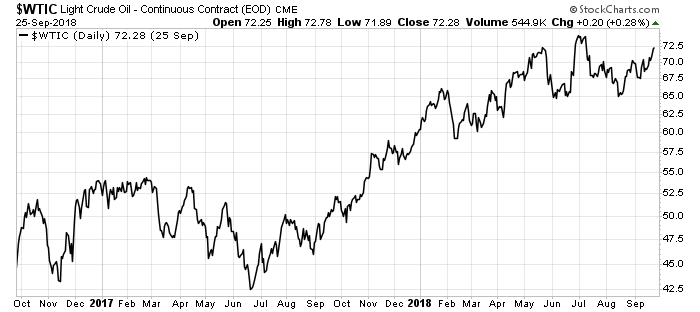The Wall Street Journal called me yesterday.
A reporter wanted my thoughts on why the oil price “suddenly” started surging. I laughed. I couldn’t help it.
You see, with all the other news stories out there about trade wars, tariffs, interest rates and the Kavanaugh hearing, the oil market was kind of forgotten in the shuffle.
But then, Wall Street has a knack for missing the beginning of a story, and that means missing out on some stellar gains.
As long-time readers of Winning Investor Daily know, the trend didn’t “suddenly” start to move. We saw this coming months ago and were able to capture some nice gains. But there’s more that Wall Street is missing…
Ahead of Wall Street
I began writing about it in March 2018. It was clear back then that the oil market could tighten. Venezuela’s production decline had the potential to take millions of barrels of oil off the market.
Then, in April 2018 we talked about the potential for nuclear sanctions against Iran.
As I explained in the spring, if the sanctions hit, we would see a much tighter oil market as supply shrinks and demand remains steady. And I predicted oil prices back up around $100 per barrel.
At that time, I suggested buying the SPDR S&P Oil & Gas Exploration ETF (NYSE: XOP). If you bought it on April 20 (when the letter went out), you would be up 12% so far. That’s a pretty good gain in five months and is ahead of the S&P 500 Index’s gain of less than 9% over the same time frame.
The reason for the rally is simple: Oil prices did exactly what we thought they would.
Just look at the chart below:

Oil prices are in a steady uptrend. As you can see, the price of West Texas Intermediate crude (the U.S. benchmark oil) rose 70% from June 2017 to today. That’s a huge increase … but it isn’t “sudden.”
As you would expect, oil investments are doing well and will continue to do so.
The Wall Street Journal is excited because Brent Crude, the European Benchmark oil price, just hit its highest point since 2014.
The reason, as we discussed in the past, is in the fundamentals.
Supply Is Down, Demand Is Up
The thesis is simple: Supply is down and could fall much further.
Venezuelan oil is going off the market at a fast clip. Over the past year, the country cut 640,000 barrels of oil production per day. That’s about 1% of global production. And while it may not sound like much, that was roughly the difference between supply and demand that pushed the oil price down into the $20 per barrel range.
So, Venezuela’s decline took all the slack out of the market. And now Iran sanctions could remove over a million barrels per day of supply in November.
The November 2018 deadline for the Iran sanctions is closing in. Countries (and companies) that talked tough back in May are now faced with reality. They can’t afford to lose access to the U.S. credit market. That’s the penalty if they keep buying Iran’s oil.
As they make new deals, the fight over spare oil heats up.
If we see more than 50% of Iran’s export oil come off the market due to sanctions, oil prices will be $100+ per barrel. That’s looking more and more likely.
This comes at a time when oil demand is hitting all-time highs. Tight supply and high demand equals rising prices.
So that’s what I told The Wall Street Journal reporter. This trend isn’t new. It’s a combination of a “tighter” market, meaning supply and demand are closer together. Any supply disruptions could spark rapid price climbs.
Add the tighter market to an uncertain political situation and you get fear. Fearful traders tend to over-react. I’m sure we will see enormous volatility in oil prices over the next few months.
I expect to see a “buy the rumour, sell the news” situation in oil. Where the runup to the sanctions see the highest oil prices. Then the market will fall off after the sanctions bite.
Here’s what you can do to profit: Hold on to your position in XOP. Plan to take a profit in late October. Get out before the sanctions kick in.
Good Investing,

Matt Badiali










